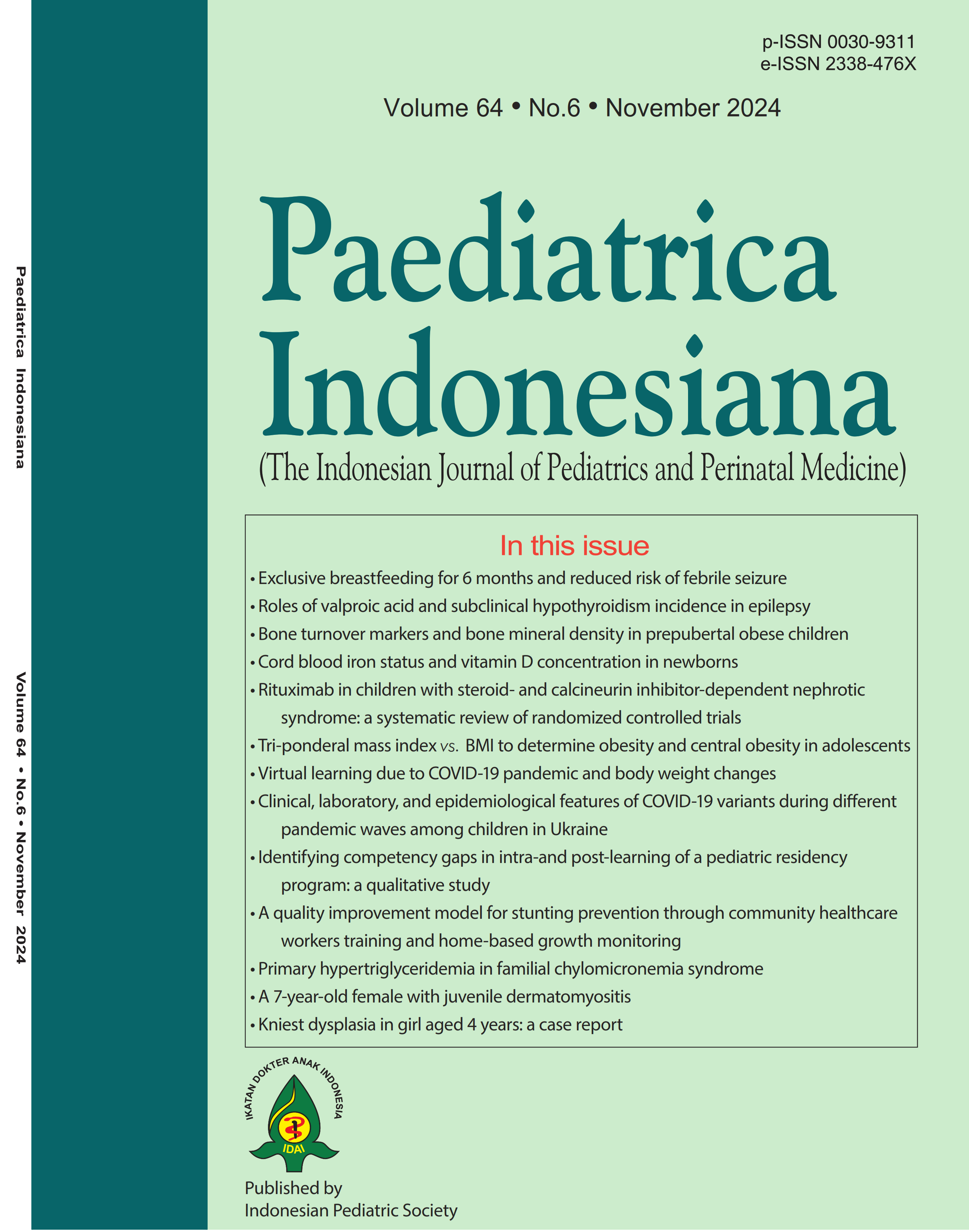Primary hypertriglyceridemia in children with familial chylomicronemia syndrome
DOI:
https://doi.org/10.14238/pi64.6.2024.546-50Keywords:
chylomicronemia; hypertriglyceridemia; medium-chain triglyceride; low-fat complementary foodAbstract
Hypertriglyceridemia can be caused by primary (genetic) or secondary etiology. One of the primary causes is hyperlipoproteinemia type I or known as familial chylomicronemia syndrome. Familial chylomicronemia syndrome is a rare autosomal recessive disease that occurs in 1-2 per 1,000,000 people, with specific characteristic signs, namely severe increment of fasting plasma triglyceride up to 100 times the normal value (about 1500-15,000 mg/dl) caused by lipoprotein lipase (LPL) mutation.
References
Falko JM. Familial chylomicronemia syndrome: A clinical guide for endocrinologists. Endocr Pract. 2018;24:758–63. DOI: https://doi.org/10.4158/EP-2018-0157
Vidanapathirana DM, Rodrigo T, Waidyanatha S, Jasinge E, Hooper AJ, Burnett JR. Lipoprotein Lipase Deficiency in an Infant With Chylomicronemia, Hepatomegaly, and Lipemia Retinalis. Glob Pediatr Health. 2017;4:4–7. DOI: https://doi.org/10.1177/2333794X17715839
Williams L, Rhodes KS, Karmally W, Welstead LA, Alexander L, Sutton L. Familial chylomicronemia syndrome: Bringing to life dietary recommendations throughout the life span. J Clin Lipidol. 2018;12:908–19. DOI: https://doi.org/10.1016/j.jacl.2018.04.010
Hegele RA, Ginsberg HN, Chapman MJ, Nordestgaard BG, Kuivenhoven JA, Averna M, et al. The polygenic nature of hypertriglyceridaemia: Implications for definition, diagnosis, and management. Lancet Diab Endocrinol. 2014;2:655–66. DOI: https://doi.org/10.1016/S2213-8587(13)70191-8
Kulkarni JD, Bhatia P, Pai SA. Strawberry pink blood. Indian J Hematol Blood Transfus. 2016;32:512–3. DOI: https://doi.org/10.1007/s12288-016-0695-6
Sandhya V, Balasubramaniam A, Rajashekhar D, Meenakshi Sundari SN. Pink blood. Int J Sci Study. 2014;2(7).
Sandmeyer LS, Osinchuk S, Leis M. Diagnostic Ophthalmology. Can Vet J. 2022;63:311-2.
Jonkers IJ, Smelt AH, Princen HM, Kuipers F, Romijn JA, Boverhof R, et al. Fish oil increases bile acid synthesis in male patients with hypertriglyceridemia. J Nutr. 2006;136:987–91. DOI: https://doi.org/10.1093/jn/136.4.987
Lindkvist B, Appelros S, Regnér S, Manjer J. A prospective cohort study on risk of acute pancreatitis related to serum triglycerides, cholesterol and fasting glucose. Pancreatology. 2012;12:317–24. DOI: https://doi.org/10.1016/j.pan.2012.05.002
Lin C, Mckenzie M, Pell J, Caplan L. Health Care Provider Satisfaction With a New Electronic Progress Note Format: SOAP vs APSO Format JAMA Intern Med. 2013;173:160–2. DOI: https://doi.org/10.1001/2013.jamainternmed.474
Iida M, Yajima I, Ohgami N, Tamura H, Takeda K, Ichihara S, et al. The effects of non-thermal atmospheric pressure plasma irradiation on expression levels of matrix metalloproteinases in benign melanocytic tumors in RET-transgenic mice. Eur J Dermatol. 2014;24:392–4. DOI: https://doi.org/10.1684/ejd.2014.2330
Solak B, Kara RO, Acikgoz SB, Kosem M. First and only symptom of undiagnosed diabetes mellitus: Eruptive xanthoma. BMJ Case Rep. 2015;2015:bcr2015212160. DOI: https://doi.org/10.1136/bcr-2015-212160
Eslick GD, Howe PRC, Smith C, Priest R, Bensoussan A. Benefits of fish oil supplementation in hyperlipidemia: a systematic review and meta-analysis. Int J Cardiol. 2009;136:4–16. DOI: https://doi.org/10.1016/j.ijcard.2008.03.092
Paquette M, Hegele RA, Paré G, Baass A. A novel mutation in GPIHBP1 causes familial chylomicronemia syndrome. J Clin Lipidol. 2018;12:506–10. DOI: https://doi.org/10.1016/j.jacl.2018.01.011
Downloads
Published
How to Cite
Issue
Section
License
Authors who publish with this journal agree to the following terms:
Authors retain copyright and grant the journal right of first publication with the work simultaneously licensed under a Creative Commons Attribution License that allows others to share the work with an acknowledgement of the work's authorship and initial publication in this journal.
Authors are able to enter into separate, additional contractual arrangements for the non-exclusive distribution of the journal's published version of the work (e.g., post it to an institutional repository or publish it in a book), with an acknowledgement of its initial publication in this journal.
Accepted 2024-12-02
Published 2024-12-02


















